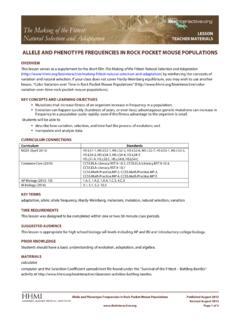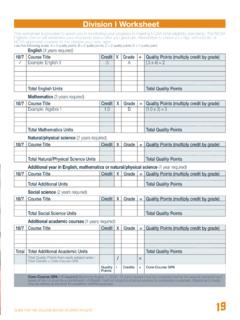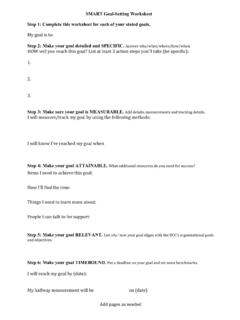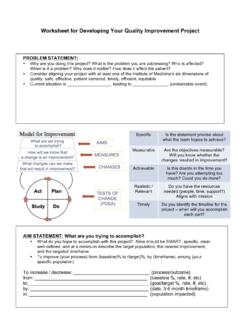Transcription of EXPLORE YOUR INNER ANIMALS WORKSHEET
1 TEACHER MATERIALS. EXPLORE your INNER ANIMALS WORKSHEET . OVERVIEW. This WORKSHEET accompanies the Click & Learn EXPLORE your INNER ANIMALS ( your - INNER - ANIMALS ). As they work through the Click & Learn, students EXPLORE multiple lines of evidence for common descent found among the bodies and cells of both extinct and extant organisms. This content was also featured in the film your INNER Fish and in the Great Transitions: The Origin of Tetrapods short film. Visit for more information. The student WORKSHEET is designed to help ensure students successfully navigate the interactive and can be completed in class or assigned as homework.
2 Students may complete all of the different sections or only some of them. KEY CONCEPTS AND LESSON OBJECTIVES. Species descend from other species. Even distantly related species, like humans and sponges, can trace their shared ancestry back to a common ancestor. Evidence for common descent includes the fossil record and anatomical, genetic, and developmental homologies among organisms. The fossil record provides a history of life on Earth. It includes fossils with features that are intermediate, or transitional, between those of major groups of ANIMALS .
3 When a series of transitional fossils are viewed together, they reveal the gradual sequence of change connecting one major group to another. An organism's DNA codes for proteins that result in an organism's visible traits. Scientists infer function and behavior from anatomical structures. Natural selection is the process by which heritable traits that confer a survival and/or reproductive advantage to individuals that possess them increase in frequency within a population over generations. CURRICULUM CONNECTIONS. Curriculum Standards NGSS (April 2013) MS-LS3-1, MS-LS4-1, MS-LS4-2.
4 HS-LS1-1, HS-LS1-2, HS-LS3-1, HS-LS4-1, HS-LS4-2, HS-LS4-4. AP (2012 13) , , , , , , , , IB (2009) , , , , Common Core (2010) KEY TERMS. adaptation, amphioxus, Ardipithecus, evolution, fossil, Gorgonopsid, natural selection, Notharctus, transitional form, primate, Proconsul, tetrapod, Tiktaalik, vertebrate TIME REQUIREMENTS. Allow one to two hours to complete the entire Click & Learn and WORKSHEET . Published April 2014. Page 1 of 5. TEACHER MATERIALS. SUGGESTED AUDIENCE. The Click & Learn and WORKSHEET are appropriate for high school biology (all levels including AP and IB) and introductory college biology.
5 PRIOR KNOWLEDGE. Most questions in the student WORKSHEET can be answered directly from the Click & Learn. Students will however benefit from having some familiarity with the concept of common descent and with the evolutionary mechanism of natural selection. MATERIALS. Internet-connected computers and head sets TEACHING TIPS. The Click &Learn and questions are divided into 6 sections. If you do not have sufficient in-class time to devote to this Click & Learn, consider breaking your class into groups, assigning each group selected sections, and then recombining the groups to share information.
6 Alternatively you can assign the whole Click & Learn and WORKSHEET to students and they can do part of the WORKSHEET for homework. The questions labeled Extend require some background knowledge of evolution and natural selection. Preview these questions and assign only those that are appropriate for your class. You may also considering answering these questions in a class discussion. Instruct students on whether they need to respond in complete sentences. RELATED RESOURCES. Skeletons Reveal Human and Chimpanzee Evolution ( ). A Click & Learn that explores human evolution and features the fossil Ardi.
7 It's a Fishapod ( ). This article by Sean B. Carroll tells the story of the search for and discovery of Tiktaalik. Great Transitions Interactive ( ). In this Click and Learn, students EXPLORE several transitional fossils in the transition from fish to tetrapods, including Tiktaalik. Young Students Recognize a Transitional Tetrapod ( ). This short video demonstrates the power of observation and the importance of fossil evidence. When Neil Shubin shows a Tiktaalik fossil to small children, they immediately notice the presence of both fish and tetrapod characteristics.
8 ANSWER KEY. Section 1 Eyes 1. How do we know that Kramer cannot see the same way most humans can? Kramer is shown a screen with a red blob on a green background. If he presses the red blob, he gets a treat. He does not press the red blob, so we know he cannot distinguish red from green like most humans can. 2. What are opsins and what do they do? Opsins are proteins in the eyes. They function to detect color. Published April 2014. Page 2 of 5. TEACHER MATERIALS. 3. Both humans and monkeys like Kramer have opsins, but monkeys like Kramer cannot see the same range of colors that most humans can.
9 Why not? Kramer only has two types of opsins. Most humans have three. For this reason humans can see more colors than monkeys. 4. Describe what the clues scientists found in our DNA suggest about how humans might have evolved enhanced color vision. Scientists found that the most recently evolved opsin gene in humans is right next to, and extremely similar to, another one of the opsin genes. This suggests that during evolution one of the genes was duplicated, and then accumulated mutations. The mutated gene codes for a protein with different functions that allow it to detect different wavelengths of light.
10 Section 2 Legs on the age of the rock in which the fossil was found, how long ago did Ardi live? million years ago 2. Why was finding a hominid of this age significant? It's around the time that the human lineage split from the lineage that gave rise to chimps and humans were becoming bipedal. 3. Describe the anatomical features of Ardi's upper and lower pelvis and what they indicate about how Ardi may have moved. The top part of the pelvis is short and broad like that of a human, which suggests that Ardi could walk on two legs.












